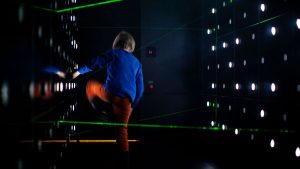Inside Spyscape, NYC’s first spy museum
Spy kids
Playacting espionage in a total design environment

Walking north on Eighth Avenue toward Spyscape—or, as it styles its name, SPYSCAPE—which is billed as “New York’s Spy Museum,” my 10-year-old son spotted Foster + Partners’s Hearst Tower, its diagrid sparkling darkly in the sun.
“Is that it?” he asked, anxious to be there already.
And why not? Joseph Urban’s sand-colored Jazz Age base effectively camouflages the 2006 tower at street level; a clever spy might time-travel via a trip through the building’s revolving doors, shirking a double-breasted suit and fedora pulled low over the eyes for a stretchy sensor-laden catsuit, the better to remain inconspicuous.
Before we even entered Spyscape, we started to see ourselves as actors in a movie, no longer mother and son but players in a game of cat and mouse.
The entrance to Spyscape, as it happens, is just south of Hearst, marked by a second-story vertical digital sign that alternately says “spyscape” and “spy museum” in the venue’s custom typeface by SomeOne. “I like the logo—the way the S is a question mark,” says the 10-year-old. Encryption has begun.
/cdn.vox-cdn.com/uploads/chorus_asset/file/10588013/Spyscape_MargaretLin_2.jpg)
Spyscape occupies the second story of a generic Midtown building, making its presence known on the street by decisive understatement: What is that big black box? You slip through a regular-size door under the sign to find out.
My son wasn’t wrong that the design would be top-notch: Adjaye Associates designed the interiors, exhibitions, and fixtures for this new for-profit venture, backed by private investment group Archimedia, with creative direction from Onedotzero and interaction design by an in-house studio led by Ross Phillips.
I asked Josh Ellman, Adjaye’s head of communications, why, after the triumph of the National Museum of African American History and Culture, a private spy museum would be your next step. “Our firm is passionate about the evolution of the museum as a typology, and we are always looking for opportunities to explore and experiment with this on a variety of scales,” Ellman says. “This was a soup-to-nuts project for us—we handled everything from the interior architecture to the exhibition design, fixtures, furnishings, and cases. As you know, this is not always feasible on larger-scale projects like the NMAAHC.”
The result is one of the most thoroughly designed experiences I have encountered, with everything from the fonts to flooring, interactive tables to Enigma machines, rendered in a materials palette that’s more Breuer than Barnum. The artifacts on offer are handsomely displayed, but what strikes you above all is the graphic consistency, and animating movement, of the way stories are told. The story of double agent Robert Hanssen, for example, becomes a series of comic-book layouts projected on a wall.
I wanted to go because I’m interested in the future of museum experiences, which too often feel either like stuff in a room or rooms made for selfies. In a more monochrome environment, would I find the play lacking at the Museum of Ice Cream?
What I didn’t expect was that I, personally, would have fun.
/cdn.vox-cdn.com/uploads/chorus_asset/file/10588015/Spyscape_MargaretLin_4.jpg)
/cdn.vox-cdn.com/uploads/chorus_asset/file/10588017/Spyscape_MargaretLin_5.jpg)
At check-in, you are issued a bracelet, a cardboard RFD tag on a ribbon that cinches tight around your wrist (10-year-old likes it so much he’s still wearing it, a week later). You’ll scan this bracelet to access each test of your espionage skills upstairs, from decryption to surveillance, agility to puzzle-solving; at the end of your visit, your scores will qualify you for one of 10 spy roles. I know immediately what I’ll end up with: Intelligence Analyst.
Even putting your coats in a locker starts to seem like part of the game. Spyscape uses four-number combination locks that you set, then bolt and rotate the number wheels to scramble. The helpful attendant suggests snapping a photo before we scramble, but 10-year-old waves him off. The staff (there is so much staff!) is uniformly friendly and helpful, outfitted in black tees that state their spy identity.
Coats secured, we step onto the Briefing Lift, a roomy 50-person elevator whose hydraulics are visible through glass. Once inside, a tiny velvet rope keeps you away from the walls. The doors close, and the reason for the rope becomes clear: The walls are screens, and for the three minutes it takes to go from G to 2, you enter a wormhole, pass through doorways hidden behind bookshelves, and float in the cosmos. It’s an orientation by disorientation, no self-destructing disc required.
My 10-year-old is wowed: “I like how futuristic it is, like you are going into the future to become a spy.” He’s less impressed by the gift shop and cafe (with Adjaye’s Washington Skin chairs). “I wanted it to go hardcore and stay hardcore,” he says.
The plan of the single-story museum is projected on the wall, a rat maze of circles and squares through which you must wend your way, overcoming new challenges around every corner. The big box is black inside as well as out, with charcoal linoleum, charcoal fiber cement panels, smoked glass, and weathering steel drums. The cold lights of projections, touch screens, and CCTV videos pull you along. Triangular kiosks dotted around the 60,000-square-foot room contain minor threats: quizzes that test your brain, personality, and capacity for risk. Purpose-built rooms and tech test your skills at encryption, deception, surveillance, and special ops.
/cdn.vox-cdn.com/uploads/chorus_asset/file/10588031/Spyscape_MargaretLin_7.jpg)
/cdn.vox-cdn.com/uploads/chorus_asset/file/10588037/Spyscape_MargaretLin_8.jpg)
Scan your bracelet and the kiosk silently greets you: HELLO ALEXANDRA LANGE. It spooks me each time. As the Briefing Lift correctly notes, our smartphones are the smartest trackers ever invented, and we buy them willingly. Paying money to Spyscape ($39 adult, $32 kid) means I’ve spent money to be surveilled yet again.
The level of the information in the museum—which 10-year-old largely skips—is set to biopic. In the first room, Encryption, there are short histories of Alan Turing and Joan Clarke, plus the costumes worn by Benedict Cumberbatch and Keira Knightley when they played Turing and Clarke in The Imitation Game. A step-by-step timeline projected on the wall explains how the Enigma encryption machines actually worked.
Projected on the far wall, above a set of digital tables like those at the Cooper Hewitt, is a tumbling set of letters, like the credits sequence for every movie you’ve ever watched about codes, whether cyphers or programming. The sensory deprivation of the black room makes it feel like we’ve gone inside the pictures, and our task here increases the sense of second-hand danger. We are to code and decode a series of messages to an operative known as the Limping Lady as the clock ticks down. Can we save her? I’m surprised to feel a frisson of danger as I scribble letters on the screen with an index finger.
My 10-year-old doesn’t trust me to know what’s good, so when I proposed this field trip, he wanted to check the website first. He was immediately won over by what I was calling the Mission Impossible room (M:I 1 is way before his time), aka Special Ops. “Dodging lasers is like dodging responsibilities!” he tells me on the subway there. It does not disappoint.
You enter a tiny chamber, and a black door shuts behind you. A grid of white buttons lights up the walls, and red “lasers” criss-cross the narrow space. Your mission is to hit as many buttons as possible in a minute and 30 seconds. I sneak in, pressing myself against the wall, so that I can see him in action. He gets 66, then it is my turn.
/cdn.vox-cdn.com/uploads/chorus_asset/file/10588051/Spyscape_MargaretLin_11.jpg)
I pretzel myself under and over the lasers, trying to hit as many buttons up and down the walls of each segment before ducking under the next red beam. My time runs out and I’ve charted an 87. Ten-year-old is aghast. Beaten by Mom. He has to—has to!—go again, and scores a 123. As I crack up, I realize we are having equal amounts of fun. Spyscape isn’t free play, but role play; it’s good to step away from being Mom and tween for a moment.
I eavesdrop on him in the Deception chamber, which forces you to lie. “Have you ever stolen anything?” the recorded voice asks. I’m happy to hear him say “Yes.” It also provides his most unexpected moment; after taking his pulse it asks, “You show no signs of lying. Are you sure you are alive?” The voice of the Spyscape is cheeky.
I won’t ruin the other challenges for you, but suffice it to say, they require close attention, and are beautifully designed. Neither of us is ever confused about which way to go or what to do next, physically or digitally. The only frustration is a repeated technical glitch in Surveillance, which means my progress keeps getting eaten by the computer. Because there is only one scenario for each challenge, that means you have to listen to the whole thing again each time. After two tries, I give up. I also realize that means this is a one-and-done experience; a repeat visit with my now very jealous 7-year-old would be boring.
/cdn.vox-cdn.com/uploads/chorus_asset/file/10588049/Spyscape_MargaretLin_12.jpg)
We end up spending two hours at Spyscape, all told, completing all the puzzles and, in the case of Special Ops, going back for more. Is the adult ticket price justified? It is certainly more stimulating than a conveyor belt of photo ops, and more targeted than a children’s museum. I wouldn’t bring a child who couldn’t read well. You can see the money in the number of personnel, the constant cleaning of equipment, the sheer number of screens.
I ask 10-year-old for his rating: four and a half stars. A half star docked for the places where the design mask slips: “There were technical difficulties,” those interruptions in Surveillance, he says. “It goes from high tech to zero tech—like in the cafe, it’s just black.” He wants swoops, a la Zaha, more like the rippling LED ceiling over the gift shop and less like a mid-range Japanese restaurant.
In the last chamber, Debrief, we scan our ID bracelets a final time, standing in front of a person-sized screen. My Brainpower stats are decent—10/18 on a series of mathematical puzzles—but my Risk factor is a disappointment: “You take risks after careful consideration.” My espionage personality? Analytical. Inquisitive. Determined. As an architecture critic with a quizzical take and a stubborn streak, that sounds about right. I am indeed suited to be an Intelligence Analyst, while 10-year-old, who embraced far more risk and beat me in agility, is an Agent Handler. We exit. You’ll have to imagine the credit sequence.
Source: Curbed NY/Alexandra Lange

 USA
USA 






 © Jackson Lieblein, LLC 2015.
© Jackson Lieblein, LLC 2015.
